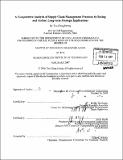A comparative analysis of supply chain management practices by Boeing and Airbus : long-term strategic implications
Author(s)
Horng, Tzu-Ching
DownloadFull printable version (8.321Mb)
Other Contributors
Massachusetts Institute of Technology. Dept. of Civil and Environmental Engineering.
Advisor
Kirkor Bozdogan.
Terms of use
Metadata
Show full item recordAbstract
The goal of this research is to develop an improved understanding of supply chain management strategies and practices being pursued by Boeing and Airbus in the 787 Dreamliner and the A380 Navigator programs, respectively, and to identify their long-term strategic implications for supply chain management in the future. The research takes as its point of departure a review and synthesis of supply chain management principles and practices, with particular emphasis on lean supply chain management concepts. Guided by this review, the research focuses on the common set of suppliers supporting both programs and employs a questionnaire survey, followed by telephone interviews with representatives of selected suppliers. The research also makes extensive use of the open source information on both companies, on both programs and on the common suppliers. (cont.) A major finding is that Boeing's new supply chain model in the 787 program represents a significant break with past practices in the aerospace industry, allowing major partnering suppliers an unprecedented role in terms of design, development, production and after-market support, where they are integrated early in the concept development stage and are incentivized to collaborate with Boeing, as well as among themselves, as risk-sharing partners with deep responsibility for system integration, involving detailed interface control at the system and subsystem levels. Airbus, as well, is found to rely heavily on its major suppliers in connection with the A380 program, but acting as the primary system integrator in the more traditional mode and exercising much greater control of all design interfaces. Also, both Boeing and Airbus have been outsourcing more and more activities to suppliers located in non-traditional regions, such as Eastern Europe and the Asia-Pacific region. Finally, aerospace manufacturers, in general, are aggressively adopting information technologies (e.g., EDI, PLM, 3-D Digital Model, RFID) to facilitate greater data sharing and communications with their partners and lower-tier suppliers dispersed in many geographical regions, as part of a broader trend involving more collaborative supplier relationships reaching down to the subtier level.
Description
Thesis (S.M.)--Massachusetts Institute of Technology, Dept. of Civil and Environmental Engineering, February 2007. Includes bibliographical references (p. 127-131).
Date issued
2007Department
Massachusetts Institute of Technology. Department of Civil and Environmental EngineeringPublisher
Massachusetts Institute of Technology
Keywords
Civil and Environmental Engineering.